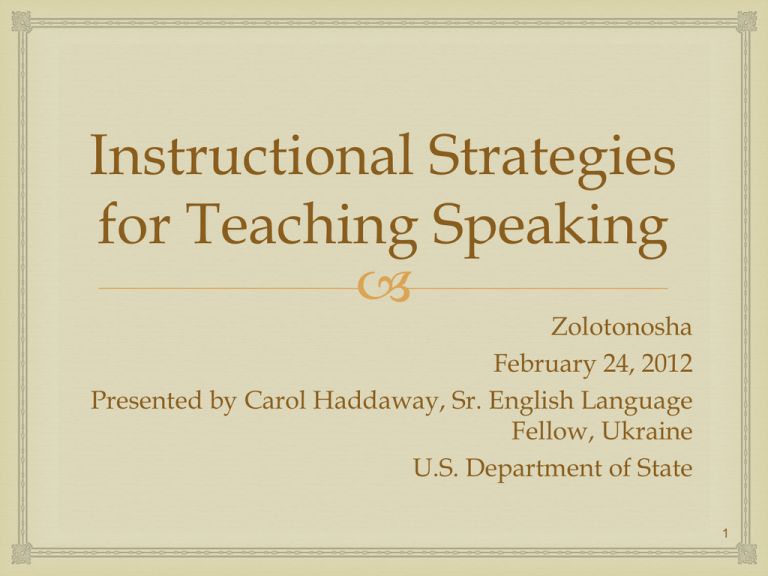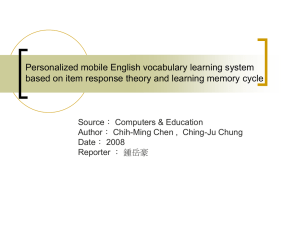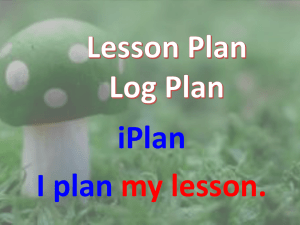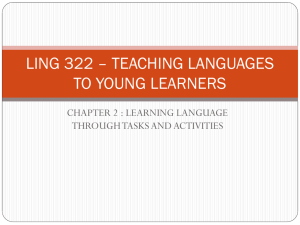
Instructional Strategies
for Teaching Speaking
Zolotonosha
February 24, 2012
Presented by Carol Haddaway, Sr. English Language
Fellow, Ukraine
U.S. Department of State
1
“Speaking in a second or
foreign language has often
been viewed as the most
demanding of the four skills.”
(Bailey and Savage in Celce-Murcia, p. 103)
2
WHY?
Because we must do it instantaneously and
interactively with another person or people.
Fluent speech contains reduced forms (what do you
want?)
slang (cool), idioms (hit the road running), phrasal
verbs (figure out)
stress, rhythm, and intonation;
During the interaction with another speaker one
must monitor and understand the other person,
think of one’s contribution, produce it, monitoring
its effect…
(Lazarton, p.103)
3
Implications for
Teaching
Create a relaxed atmosphere
Use interesting topics and stimulating activities
Expose Ls to naturally pronounced speech and
integrate pronunciation into your lesson
Get Ls used to combining listening and speaking
in real time, in natural interaction.
Establish English as the main classroom
language
(Davies , 2000, p. 82)
4
“Talking classrooms”
Create a classroom culture of speaking
through the general use of English in the classroom.
(Scott Thornbury in Harmer, p. 123)
5
Learners: motivate, involve, focus
create expectations, introduce topic
Information Gap
Oral Skills Class
Who are my learners?
7
Low Level Learners
Build on their experience
Share their expertise
Use realia to keep learning as concrete as
possible
S1: Have you ever been to Lviv?
S2: No I haven’t . Have you?
S1: Yes. It’s wonderful
S2: How long did you stayed?
S1: One week
S2: The buildings are beautiful, yes?
S1: Yes, and the streets….the chocolates..
S2: Ah, have you ever been to Kyiv?
8
Non-academic learners
BICS (Basic interpersonal Communication
Skills)
Social language – interpersonal interactions
Repetitive – functional language (greetings,
making requests, giving directions, sharing
information).
Evidence of mastery: good TL pronunciation,
ease of TL social interactions, use of TL
expressions
Used primarily, though not exclusively in oral
language – listening and speaking
Takes 2-3 years to master
(Jim Cummings, 1970)
9
Academic Learners
CALP (Cognitive Academic Language Proficiency)
Language encountered in academic situations
Used primarily thought not exclusively in reading and
writing
Not repetitive
Takes on average 7-9 years to become truly fluent
Participate in learning activities such as
Class participation
Discussions & Presentations
Interacting with peers and professors
Asking and answering questions
Interpersonal communication
(Jim Cummings, 1970)
10
Teacher, Learners, Atmosphere
Error Correction, Activities
Small Groups
Affective Filter
12
Balance Accuracy and
Fluency
Is it more important to be able to speak a
language with accuracy (grammatically correct)
or with fluency (communicatively correct, but
not always grammatically correct)?
13
Accuracy
Practice typically involves focusing only in
the new language structures (e.g.
comparisons)
Focus on pronunciation, vocabulary, word
formation, sentence formation
Errors are usually dealt with immediately
14
Accuracy example
L1: Is the Toyota bigger than the Chevy?
L2: Yes, it is. Is the Lexus cheap than….
Teacher: Cheap…?
L2: Is the Lexus cheaper than the Chevy?
L3: No, it isn’t. Is the Lexus faster than the Toyota?
L4: Yes, it is. Is prettier the Toyota?
Teacher: Is the……..
15
Fluency
Likely to take place when
speaking activities focus on
meaning and its negotiation, when
speaking strategies are used, and
when overt correction is minimized.
)
10
Information Gap
Think Pair Share
Telling Stories
18
Information Gap
Characteristics
To exchange information
Main attention is sharing information
Need to communicate to reach objective
Learners must ‘fill the gap’ to complete the
activity/communication
Why information gap
activities?
Allow for comprehensible input (i+1)
Input should be at the right level of
difficulty to promote acquisition
Learners produce language – this output
‘pushes’ learners to undertake complete
grammatical processing (M. Swain)
Help lower students’ affective filter
Sleep questionnaire
One thing in common
Cooperative Activity
Think
Pair
Share
21
Think-Pair-Share
How:
Teacher presents a question or problem
Students are given “think/wait time” and write answers
(1)
Students pair with a partner (2)
Pair share with another pair (4)
Group share their responses and ideas with another small
group or with the entire class.
Why:
Have time to think, plan, and rehearse, with feedback
Can practice before talking to whole group
Question/Problem 1
Interaction is the key to improving EFL
learners’ speaking ability. How do you
promote this interaction in your
classroom?
23
Question/Problem 2
What types of speaking activities do
you normally use in your classroom?
Do they serve different purposes?
24
Question/Problem 3
Your students are really shy and don’t
say anything. How do you arouse in
your learners a willingness and need or
reason to speak?
25
26
Question/Problem 4
Your students say they can’t talk
because they’ll make lots of mistakes.
What do/can you do to help them
overcome this fear?
27
Question/Problem 5
What are effective ways to give
students feedback on their performance
during oral activities?
28
Feedback and Error
Correction
Self – Correction
Give learners the opportunity to correct
themselves, helping as necessary
Peer – Correction
If learner cannot self-correct, invite other learners
to make the correction
Teacher Correction
Recast, Error or Mistake, Accuracy or Fluency
focus
29
Error Treatment
Should errors be treated?
What errors should be treated?
How should they be treated?
Who and When?
“There is a French widow in every bedroom.”
“The different city is another one in the
another two.”
Story telling
Groups of 3
31
A successful speaking activity
Learners talk a lot
Student (STT) vs teacher (TTT) – wait time
Participation is even
discussion not dominated by a minority of talkative
students
Motivation is high
learners are eager to speak; interested in topic
Language is of an acceptable level
utterances are easily comprehensible
acceptable level of accuracy
UR, 1991, p. 120
32
(Rivers, 1987 in Richards & Renandyn, p.208)
33
References
Brown, H.D. (2001). Teaching by Principles. Longman
Davies, P. and Pearse, E. (2000). Success in English
Teaching. Oxford University Press.
Farrell, T. (2006). Succeeding with English Language
Learners. Corwin Press.
Harmer, J. (2007). How to teach English. Pearson
Longman.
Lazaraton, A. (2001). Teaching Oral Skills. In
Teaching English as a Second or Foreign Language 3rd
Ed., edited by M. Celce-Mircia. Heinle & Heinle.
Richards, J.C. & Renandya, W.A. (2002). Methodology
in Language Teaching. Cambridge.
Ur, P. (1996).. A Course in Language Teaching.
Cambridge.
34
Thank you!
35







